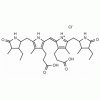Stercobilin hydrochloride (mixture of isomers) CAS: 34217-90-8 MDL: MFCD00216795
SDS
Molecular weight: 631.22g/mol
Molecular Formula:C33H47ClN4O6
CAS Number: 34217-90-8
Storage: Store at 0-4 °C, protect from light.
Synonyms: STERCOBILIN HYDROCHLORIDE, SCHEMBL3891783, (-)-stercobilin, 17G380DO11, 21H-Biline-8,12-dipropanoic acid, 3,18-diethyl-1,2,3,4,5,15,16,17,18,19,22,24-dodecahydro-2,7,13,17-tetramethyl-1,19-dioxo-, (2R,3R,4S,16S,17R,18R)-, 251-887-8, 34217-90-8, stercobilin, UNII:17G380DO11, (2R,3R,4S,10Z,16S,17R,18R)-3,18-diethyl-2,7,13,17-tetramethyl-1,19-dioxo-1,2,3,4,5,15,16,17,18,19,22,24-dodecahydro-21H-biline-8,12-dipropanoic acid, (2R,3R,4S,16S,17R,18R)-3,18-diethyl-1,2,3,4,5,15,16,17,18,19,22,24-dodecahydro-2,7,13,17-tetramethyl-1,19-dioxo-21H-biline-8,12-dipropanoic acid, (2R,3R,4S,16S,17R,18R)-3,18-diethyl-1,2,3,4,5,15,16,17,18,19,22,24-dodecahydro-2,7,13,17-tetramethyl-1,19-dioxo-21H-biline-8,12-dipropionic acid, 5326728, L-Stercobilin, stercobilin IX, UNII-17G380DO11
Field of Interest: Heme Oxygenase Pathway, HIV Protease Inhibitors, Bile Pigments
Background: Stercobilin Hydrochloride is produced via the oxidation of stercobilinogen, a degradation product of bilirubin, and excreted in the feces. Bilirubin is a water insoluble tetrapyrrole produced from the reduction of biliverdin in a reaction catalyzed by the enzyme bilirverdin reductase. Water insoluble bilirubin (also called indirect bilirubin) undergoes glucuronidation in the liver (addition of one or two glucuronic acids through a glycosidic bond) to form the water soluble bilirubin mono or diglucuronide (also called bilirubin conjugate or direct bilirubin). Bilirubin conjugate is excreted from the liver in bile or is converted to mesobilinogen via gut bacteria and then to urobilinogen and excreted in the urine as urobilin or stercobilinogen and excreted in the feces as stercobilin. Stercobilin Hydrochloride is soluble in basic aqueous solutions (pH > 9 for initial dissolution) and soluble down to pH 7 once in solution as well as methanol and ethanol if made slightly basic. Bile pigments including stercobilin are active as HIV protease inhibitors.
References:
1.) Quinn, K. D., N. Q. T. Nguyen, et al. (2012). “Tandem mass spectrometry of bilin tetrapyrroles by electrospray ionization and collision-induced dissociation.” Rapid Communications in Mass Spectrometry 26(16): 1767.
2.) Nakamura, T., T. Nagura, et al. (2010). “Promotive Effects of the Dietary Organic Germanium Poly-trans-[(2-carboxyethyl) germasesquioxane] (Ge-132) on the Secretion and Antioxidative Activity of Bile in Rodents.” Journal of Health Science 56(1): 72.
3.) Lee, W. H., J. M. Lee, et al. (2013). “Structural requirements within protoporphyrin IX in the inhibition of heat shock protein 90.” Chemico-Biological Interactions 204(1): 49.
4.) Molzer, C., B. Pfleger, et al. (2013). “In vitro DNA-damaging effects of intestinal and related tetrapyrroles in human cancer cells.” Experimental Cell Research 319(4): 536.
5.) F McPhee, P S Caldera, G W Bemis, A F McDonagh, I D Kuntz, and C S Craik. (1996). Bile pigments as HIV-1 protease inhibitors and their effects on HIV-1 viral maturation and infectivity in vitro. Biochem J. 1996 Dec 1; 320(Pt 2): 681–686.

